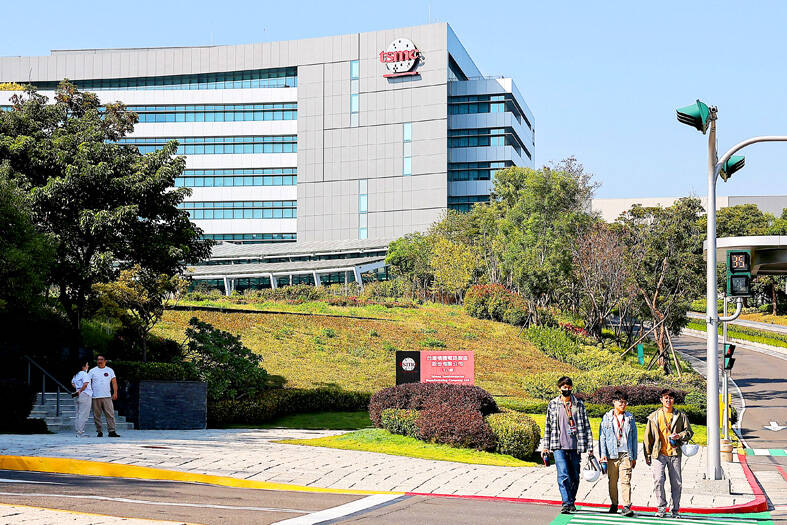Taiwan Semiconductor Manufacturing Co (TSMC, 台積電) retained the No. 1 title in the global pure-play wafer foundry business in the third quarter of this year, seeing its market share growing to 64.9 percent to leave South Korea’s Samsung Electronics Co, the No. 2 supplier, further behind, Taipei-based TrendForce Corp (集邦科技) said in a report.
TSMC posted US$23.53 billion in sales in the July-September period, up 13.0 percent from a quarter earlier, which boosted its market share to 64.9 percent, up from 62.3 percent in the second quarter, the report issued on Monday last week showed.
TSMC benefited from the debut of flagship smartphone products, as well as strong demand for high-performance computing (HPC) devices, which helped it report an increase in revenue in the third quarter, the report said.

Photo: REUTERS/Ann Wang
The chipmaker also saw an increase in production capacity utilization and wafer shipments, it said.
On the other hand, Samsung, with its clients’ products approaching the end of the life cycle and the company facing rising competition in mature processes from Chinese rivals, posted US$3.36 billion in sales in the third quarter, down 12.4 percent from a quarter earlier, the report said.
Despite retaining the No. 2 position, Samsung’s market share fell to 9.3 percent in the third quarter, down from 11.5 percent in the second quarter, leaving it further behind TSMC, according to TrendForce.
In the third quarter, the aggregate sales of the world’s top pure-play wafer foundry operators stood at about US$34.9 billion, up 9.1 percent from a quarter earlier and breaking the record set during the COVID-19 pandemic, the report said.
TrendForce attributed part of the growth to the substantial contributions from the advanced 3-nanometer (nm) process.
China’s Semiconductor Manufacturing International Corp (中芯) came in third place after posting US$2.17 billion in revenue in the third quarter and a market share of 6.0 percent, ahead of Taiwan’s United Microelectronics Corp (聯電) with US$1.87 billion in revenue and a 5.2 percent market share, and US-based GlobalFoundries Inc with US$1.74 billion in revenue and a 4.8 percent market share, the report showed.
China’s Huahong Group (華虹) took the sixth spot after generating US$799 million in revenue in the third quarter and securing a 2.2 percent market share.
It was followed by Israel’s Tower Semiconductor Ltd with US$371 million, or 1 percent, Taiwan’s Vanguard International Semiconductor Corp (世界先進) with US$366 million, or 1 percent, Taiwan’s Powerchip Semiconductor Manufacturing Corp (力積電) with US$336 million, or 0.9 percent, and China’s NexChip Co (晶合集成) with US$332 million, or 0.9 percent, the report added.
TrendForce said robust global demand for emerging technologies is expected to boost sales of the world’s top 10 pure-play wafer foundry operators in the fourth quarter, with a tight supply in sophisticated 5nm and 3nm processes expected to fail to meet solid demand.
However, demand for mature processes, which refers to the 28nm and lower-end technologies, would see little change or rise slightly in the fourth quarter, TrendForce said.

Micron Memory Taiwan Co (台灣美光), a subsidiary of US memorychip maker Micron Technology Inc, has been granted a NT$4.7 billion (US$149.5 million) subsidy under the Ministry of Economic Affairs A+ Corporate Innovation and R&D Enhancement program, the ministry said yesterday. The US memorychip maker’s program aims to back the development of high-performance and high-bandwidth memory chips with a total budget of NT$11.75 billion, the ministry said. Aside from the government funding, Micron is to inject the remaining investment of NT$7.06 billion as the company applied to participate the government’s Global Innovation Partnership Program to deepen technology cooperation, a ministry official told the

Taiwan Semiconductor Manufacturing Co (TSMC, 台積電), the world’s leading advanced chipmaker, officially began volume production of its 2-nanometer chips in the fourth quarter of this year, according to a recent update on the company’s Web site. The low-key announcement confirms that TSMC, the go-to chipmaker for artificial intelligence (AI) hardware providers Nvidia Corp and iPhone maker Apple Inc, met its original roadmap for the next-generation technology. Production is currently centered at Fab 22 in Kaohsiung, utilizing the company’s first-generation nanosheet transistor technology. The new architecture achieves “full-node strides in performance and power consumption,” TSMC said. The company described the 2nm process as

Shares in Taiwan closed at a new high yesterday, the first trading day of the new year, as contract chipmaker Taiwan Semiconductor Manufacturing Co (TSMC, 台積電) continued to break records amid an artificial intelligence (AI) boom, dealers said. The TAIEX closed up 386.21 points, or 1.33 percent, at 29,349.81, with turnover totaling NT$648.844 billion (US$20.65 billion). “Judging from a stronger Taiwan dollar against the US dollar, I think foreign institutional investors returned from the holidays and brought funds into the local market,” Concord Securities Co (康和證券) analyst Kerry Huang (黃志祺) said. “Foreign investors just rebuilt their positions with TSMC as their top target,

H200 CHIPS: A source said that Nvidia has asked the Taiwanese company to begin production of additional chips and work is expected to start in the second quarter Nvidia Corp is scrambling to meet demand for its H200 artificial intelligence (AI) chips from Chinese technology companies and has approached contract manufacturer Taiwan Semiconductor Manufacturing Co (TSMC, 台積電) to ramp up production, sources said. Chinese technology companies have placed orders for more than 2 million H200 chips for this year, while Nvidia holds just 700,000 units in stock, two of the people said. The exact additional volume Nvidia intends to order from TSMC remains unclear, they said. A third source said that Nvidia has asked TSMC to begin production of the additional chips and work is expected to start in the second